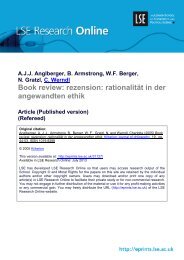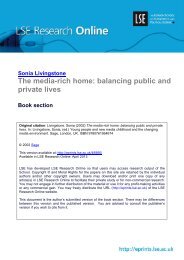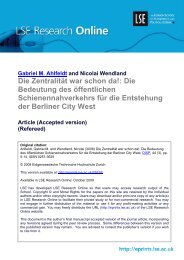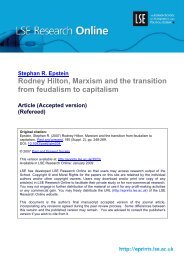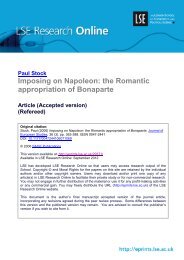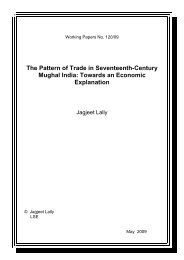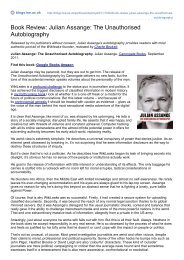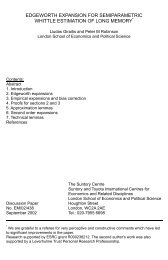Download (307Kb) - LSE Research Online
Download (307Kb) - LSE Research Online
Download (307Kb) - LSE Research Online
You also want an ePaper? Increase the reach of your titles
YUMPU automatically turns print PDFs into web optimized ePapers that Google loves.
UNCTAD. (2010) Creative Economy Report 2010. Geneva: UNCTAD at<br />
http://www.unctad.org/Templates/WebFlyer.asp?intItemID=5763&lang=1,<br />
accessed 05/04/2011.<br />
UNESCO. (2005) Convention on the Protection and Promotion of the Diversity of Cultural<br />
Expressions. Paris: UNESCO at<br />
http://www.unesco.org/new/en/unesco/themes/2005‐convention/the‐<br />
convention/convention‐text/, accessed 05/04/2011.<br />
Venturelli, S. (1998) Liberalizing the European Media. Oxford: Clarendon.<br />
Verhulst, S. (2002) 'About Scarcities and Intermediaries: The Regulatory Paradigm Shift<br />
of Digital Content Reviewed', in L. A. Lievrouw and S. Livingstone (Eds),<br />
Handbook of New Media: Social Shaping and Consequences of ICTs (pp. 432‐447).<br />
London: Sage.<br />
Wiener, N. (1948/1961) Cybernetics: Or Control and Communication in the Animal and<br />
Machine. Cambridge MA: MIT Press.<br />
Notes<br />
i See also (Garnham, 2005).<br />
ii (UNCTAD, 2010: 128). This includes arts crafts, audiovisuals, design, new media, performing<br />
arts, and publishing and visual arts. Definitions vary, see (Rosted, et al., 2010).<br />
iii (TERA Consultants, 2010). This definition includes film and video, videogames, broadcasting,<br />
music, books and press publishing as core industries and non‐core activity (on‐site consumption<br />
at live concerts, art fairs and exhibitions) as well as design, architecture, and advertising. These<br />
estimates include software and databases and allocations from sectors needed to distribute the<br />
output of the creative industries such as transport, telecommunications and post.<br />
iv The non‐rivalry of information (if I use your information you do not reduce my holdings and it<br />
is difficult to exclude people from accessing information), and ‘expansibility’ (once the costs of a<br />
first digital copy are covered, an unlimited number of copies can be made without significant<br />
additional cost) create challenges for standard economic analysis.<br />
v Key works on the economics of information include (Arrow, 1984; Lamberton, 1971).<br />
vi See<br />
http:// www.theregister.co.uk/2010/11/30/yahoo_chief_economist_on_google_antitrust_questio<br />
n/, accessed 05/04/2011.<br />
vii See<br />
http://www.theregister.co.uk/2010/11/30/comcast_and_level_3_clash_over_transit_fees/,<br />
accessed 05/04/2011.<br />
viii The public value concept was developed in the United States (Moore, 1995) to understand<br />
how public sector organisations might aim to operate in a way that is perceived as being<br />
substantively valuable, legitimate and politically sustainable. See (Kelly, et al., 2002) and<br />
(Jakubowicz, 2011; Moe, 2010).<br />
16





